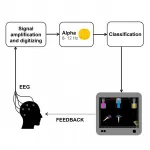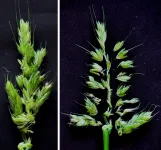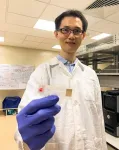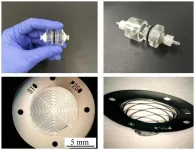Faster, greener technique to improve recycling process for electric vehicle batteries
Ultrasonic delamination technique to return high purity materials to new battery manufacture
2021-06-29
(Press-News.org) HARWELL, UK (29 June 2021) Researchers working on the Faraday Institution project on the recycling of lithium-ion batteries (ReLiB) at the Universities of Leicester and Birmingham have solved a critical challenge in the recovery of materials used in electric vehicle batteries at the end of their life, enabling their re-use in the manufacture of new batteries. The new method, which uses ultrasonic waves to separate out valuable material from the electrodes, is 100 times quicker, greener and leads to a higher purity of recovered materials relative to current separation methods.
The research has been published in Green Chemistry and the team have applied for a patent for the technique.
To ensure the environmental and economic benefits from EV batteries are fully realised, Faraday Institution researchers have been focused on the life cycle of the battery - from their first production to their re-use in secondary applications to their eventual recycling. One key stumbling block has been in materials segregation, that is how to remove and separate the critical materials - such as lithium, nickel, manganese and cobalt - from used batteries in a fast, economical and environmentally-friendly way.
The ReLiB team in Leicester and Birmingham devised a novel ultrasonic delamination technique that blasts the active materials from the electrodes leaving virgin aluminium or copper. This process proved highly effective in removing graphite and lithium nickel manganese cobalt oxides, commonly known as NMC. Materials recovered using the technique were found to have higher purity, and therefore higher value, than those recovered in conventional recycling approaches and are potentially easier to use in new electrode manufacture. The approach is fast and adapts technology in widespread use in the food preparation industry.
"For the full value of battery technologies to be captured for the UK, we must focus on the entire life cycle -- from the mining of critical materials to battery manufacture to recycling -- to create a circular economy that is both sustainable for the planet and profitable for industry," commented Professor Pam Thomas, CEO, The Faraday Institution.
"This effort to deliver commercial, societal and environment impact for the UK is showing great promise. It is imperative that academia, industry and government redouble their efforts to develop the technological, economic and legal infrastructure that would allow a UK EV battery recycling industry to become established to realise the full benefits of a decarbonised transport sector."
"This novel technique works in the same way as a dentist's ultrasonic descaler, breaking the adhesive bonds between the coating layer and the substrate," comments Professor Andrew Abbott at the University of Leicester who leads the research. "It is likely that the initial use of the technology will use production scrap from battery manufacturing facilities as the feedstock and feed recycled material straight back into the battery production line, possibly at the same site. This could be a real step change in battery recycling."
Current delamination recycling techniques use concentrated acids in a batch immersion process. The new ultrasonic technique is a continuous, feed process that uses water or dilute acids as the solvent so the technique is greener and less expensive to operate. It can delaminate 100 times more electrode material in a given time and volume than existing batch delamination techniques.
Researchers are in initial discussions with several battery manufacturers and recycling companies to place a technology demonstrator at an industrial site in 2021, with a longer-term aim to license the technology. The research team at the Universities of Leicester and Birmingham have tested the technology on the four most common battery types and find that it performs with the same efficiency in each case.
INFORMATION:
A media pack is available.
https://www.youtube.com/watch?v=x0AjZEl9Wos
https://www.youtube.com/watch?v=g_uA9MMjp-0
https://www.faraday.ac.uk/wp-content/uploads/2021/06/Ultrasonic-Delamination-Infographic.jpg
A more efficient process for industry
Current recycling methods for lithium-ion battery recycling typically feed end-of-life batteries into a shredder or high-temperature reactor. A complex set of physical and chemical processes are subsequently needed to produce useable materials streams of the lithium, cobalt, nickel and copper they contain. Such pyrometallurgical and hydrometallurgical recycling routes are energy intensive and inefficient.
If an alternate approach is taken and end-of-life batteries are disassembled rather than shredded there is the potential to recover more material, in a purer state, so recovering materials with greater value than current approaches. The disassembly of lithium-ion batteries has been shown to recover a high yield (around 80% of the original material) in a purer state than was possible using shredded material.
However, for disassembly to be used, battery cells, modules and packs must be designed for recycling so that cells can be disassembled, and their anodes and cathodes separated at the end of the battery's first life. Battery disassembly is currently carried out at a scale of 100,000 tonnes/year in recycling facilities in the Far East. However, the majority of other battery manufacturers currently glue battery components together during manufacture for increased stability, but this makes them unsuitable for disassembly and high value recycling processes.
Some automakers are realising the importance of recycling considerations in product design as a necessity in creating a circular economy for battery raw materials. Design for recycle aims to work with manufacturers to bring about minor changes to product structures so that raw materials can be returned more easily to the manufacturing process at potentially half the cost compared with primary sources.
ELSE PRESS RELEASES FROM THIS DATE:
2021-06-29
Patients with mild Covid-19 infections experience a significantly increased longer lasting reduced sense of taste and smell. This is also the case for long-term shortness of breath, although relatively few people are affected. And women and the elderly are particularly affected. This is shown by new research findings from Aarhus University Aarhus University Hospital and Regional Hospital West Jutland
The last 14 months have taught us that there are different symptoms and outcomes of Covid-19. However, the vast majority of people who fall ill with Covid-19 experience mild symptoms and get over ...
2021-06-29
Attention Deficit Hyperactivity Disorder (ADHD) affects about 7% of children, with a two out of three chance of persisting into adulthood. This neurodevelopmental disorder is characterised by concentration difficulties, increased distractibility, impulsivity and hyperactivity. Today, ADHD is treated with pharmaceutical drugs that may have unwanted side effects. This is why scientists from the University of Geneva (UNIGE) and the University Hospitals of Geneva (HUG), Switzerland, explored a new technique called 'neurofeedback', which enables ADHD patients to train their attention, based on instant feedback from the level of their brain activity. The team of neuroscientists found that not only did the training have a positive effect on patients' concentration abilities, but also that the ...
2021-06-29
An international team of researchers has identified a novel mechanism in barley plants, which could help crop growers achieve high yields as temperatures rise.
With grain production highly sensitive to changing environmental conditions, rising temperatures are known to reduce the number of seeds that can be produced on each plant. One solution is to increase the number of flowers or branches on each 'spike', which is the reproductive structure from which grain is harvested.
In a study published in Nature Plants, research led by Professor Dabing Zhang from the University of Adelaide's Waite Research Institute and Shanghai Jiao Tong University's Joint Lab for Plant Science and Breeding, explored the possibility of increasing seed production through ...
2021-06-29
Tsukuba, Japan - As far back as the 1930s, inventors have commercialized fuel cells as a versatile source of power. Now, researchers from Japan have highlighted the impressive chemistry of an essential component of an upcoming fuel cell technology.
In a study recently published in The Journal of Physical Chemistry Letters, researchers from the University of Tsukuba have revealed successive proton transport--energy transfer--in an advanced carbon-based crystal for future fuel cells, and the chemistry that underpins this phenomenon.
Such crystals are exciting as solid electrolytes--energy transfer media--in upcoming fuel cell technologies. Solid electrolytes have advantages, such as high power efficiency and long-term ...
2021-06-29
Researchers have revealed that praying mantis (mantids) infected with parasitic hairworms are attracted to horizontally polarized light that is strongly reflected off the surface of water, which causes them to enter the water. In a world-first, these research results demonstrate that parasites can manipulate the host's specific light perception system to their advantage, causing the host to behave in an abnormal manner.
This discovery was made by an international research group consisting of Graduate student OBAYASHI Nasono, Associate Professor SAKURA Midori and Associate Professor SATO Takuya of Kobe University's Graduate School of Science, Associate Professor IWATANI Yasushi (Faculty of Science and Technology, Hirosaki University), ...
2021-06-29
A team of scientists from Nanyang Technological University, Singapore (NTU Singapore) has developed a test kit for malaria that delivers results in 30 minutes. The kit could facilitate the diagnosis of malaria in the field, as the equipment needed is anticipated to be lightweight, easy-to-use, and able to detect the disease in its early stages.
According to the World Health Organisation (WHO), an estimated 229 million people suffered from malaria in 2019. The disease, transmitted by mosquitoes, caused the deaths of 409,000 people across 87 mainly developing countries.
Efforts to treat and control malaria in ...
2021-06-29
A microfilter device that can easily separate and capture trace amounts of cancer cells in blood has been developed by a Kumamoto University research group. The palm-sized device is expected to contribute to the development of new cancer diagnostic technologies based on cancer cells in the blood, such as early detection by blood test, postoperative management, and recurrence monitoring.
The blood of people with cancer contains trace amounts of cancer cells (CTCs) that have detached from the primary cancer site. However, the amount of these cells is only a few per milliliter, whereas red or white blood cells number in the billions, making ...
2021-06-29
INDIANAPOLIS - With the growing prevalence of chronic pain, depression, anxiety, and other symptom-based conditions, physicians and the healthcare systems for which they work are increasingly considering how to augment the care they can provide within the limited time allotted for patient appointments.
According to Regenstrief Institute Research Scientist Kurt Kroenke, M.D., writing in the Journal of General Internal Medicine (JGIM), collaborative care can and should play a major role targeting the treatment of symptoms and functional decline, both too frequently marginalized in medically oriented care delivery.
Collaborative care is a team-based ...
2021-06-29
Neoadjuvant immune checkpoint blockade (ICB) is a promising treatment for melanoma and other cancer types, and has recently been shown to provide a modest survival benefit for patients with recurrent glioblastoma. To improve the treatment efficacy, researchers are looking for vulnerabilities in surgically removed glioblastoma tissues, but this has been difficult due to the vast differences within the tumor and between patients.
To address this challenge, researchers at Institute for Systems Biology (ISB) and their collaborators developed a new way to study tumors. The method builds ...
2021-06-29
Sophia Antipolis - 29 June 2021: Heart attacks during the COVID-19 pandemic were more likely to result in heart failure compared with heart attacks one year earlier, according to research presented today at Heart Failure 2021, an online scientific congress of the European Society of Cardiology (ESC).1
"Heart attack patients waited an average of 14 hours to get help during the pandemic, with some delaying for nearly two days. That compares to a delay of six hours in the previous year," said study author Dr. Ali Aldujeli of the Hospital of Lithuanian University of Health Sciences, Kaunas, Lithuania. "This gap may have been one contributor to the higher incidence of subsequent heart failure."
Urgent treatment for heart attacks is essential to restore the flow of oxygen-rich ...
LAST 30 PRESS RELEASES:
[Press-News.org] Faster, greener technique to improve recycling process for electric vehicle batteries
Ultrasonic delamination technique to return high purity materials to new battery manufacture





